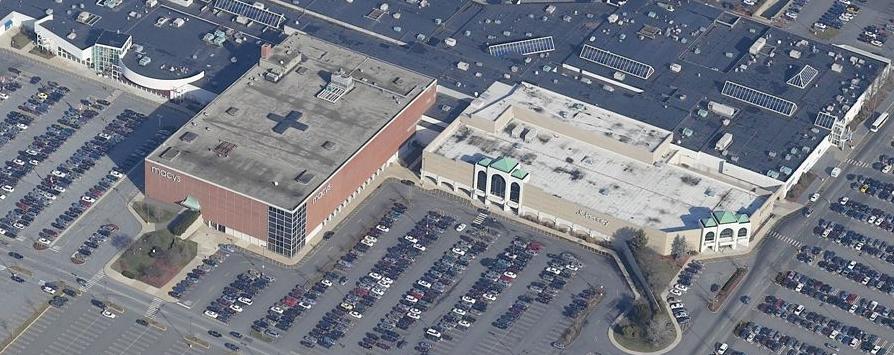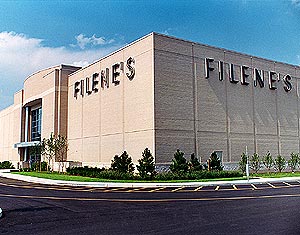
According to this article, Federated Department Stores (the parent company of Macy’s) is selling nine former stores to General Growth Properties. This is just a small part of the divestitures occurring in areas where Macy’s had a substantial amount of overlap with a former May chain (such as Filene’s, Kaufmann’s, Strawbridge’s, Robinsons-May, etc.). In many instances, there is no obvious traditional department store to replace the departed May chain in these spaces, and most of the ones who do exist aren’t in a position to expand into these spaces. JCPenney, whose financial situation continues to improve, is a likely candidate for some, but in many malls they already have a presence. Boscov’s (who I would love to see building a presence in New England) has taken all of the locations they can possibly absorb given their size, Nordstrom only makes sense in malls and metropolitan areas with certain demographics, and The Bon Ton is busy integrating the former Saks chains in the midwest that they acquired only a few months back. Dillard’s could take some stores, but they’re very far from many areas like the northeast that have the highest concentrations of May anchors gone dark. Target, Kohl’s, and Wal-Mart may make sense for malls located in dense, more urban areas where land is scarce and development is difficult, but all tend to prefer to avoid malls in most cases.
 There’s also the problem that many of the shells left dark–whether they were originally a May or Federated space–are far too large by modern department store standards. In New England, Macy’s has tended to prefer to keep the smaller and more modern Filene’s spaces over their own spaces, which were all acquired from Jordan Marsh a decade ago. Many of these former Jordan Marsh stores had in excess of 300,000 or even 400,000 square feet, and sometimes featured four levels of sales floors fronting a one-level mall (The Northshore Mall in Peabody, Mass. and the Warwick Mall in Warwick, RI both spring to mind). There just aren’t any chains in expansion mode that would want to occupy a space like this anymore, so the buildings will almost certainly have to come down.
There’s also the problem that many of the shells left dark–whether they were originally a May or Federated space–are far too large by modern department store standards. In New England, Macy’s has tended to prefer to keep the smaller and more modern Filene’s spaces over their own spaces, which were all acquired from Jordan Marsh a decade ago. Many of these former Jordan Marsh stores had in excess of 300,000 or even 400,000 square feet, and sometimes featured four levels of sales floors fronting a one-level mall (The Northshore Mall in Peabody, Mass. and the Warwick Mall in Warwick, RI both spring to mind). There just aren’t any chains in expansion mode that would want to occupy a space like this anymore, so the buildings will almost certainly have to come down.
Because of this shift, many of the former May stores (most of which were owned by May, not by the mall’s management company) are being sold back to the malls rather than to new tenants. In most cases, the malls are promising to rebuild the spaces to hold new tenants or to incorporate more in-line space. A few things that I think we’re likely to see:
- Outdoor, faux-“lifestyle” promenades, complete with more upscale retailers and restaurants. Many in-line mall stores who are trending towards an anchor format (Crate & Barrel, H&M, Pottery Barn, Restoration Hardware) will flock towards these areas. My own take on this type of development, however, is that it’s superficial and trendy in the bad way. They don’t really suit the existing development of the mall, turning their backs on the present hubs of activity inside of the mall corridors, and instead turn onto… a sea of asphalt in the mall parking lot. I think the litmus test for successfully creating the kind of outdoor shopping environment that’s necessary for a good “lifestyle center” (and can you tell how much I just hate that name?), should be: Is it pleasant enough to sit outside and have lunch? Are you looking at fountains and pedestrians and landscaping, or a nice view, or are you looking at a parking lot? If the answer is the latter, then it’s doomed, and these lifestyle areas will look dated quickly.
- Tear down the existing boxes to make room for new, 21st century tenants. I think this is a generally better idea. We’ve seen a shift away from traditional mall anchor stores and towards big box stores over the past decade or two, but why? While price is certainly an issue (especially with Wal-Mart), I maintain it has more to do with convenience. Americans work longer hours, have longer commutes, and have more choices for entertainment than they used to. If it’s 6pm on a Wednesday night, and you need some essentials, do you want to blow your entire evening at a mall or would you rather pick them up at Target in a half hour? Most would probably pick the latter. The most successful modern malls have realized this shift, and no longer target the convenience-oriented customer but rather the leisure shopper. These people are shopping for fun; buying items they may not need but are probably excited about buying, and are doing so at a leisurely time as a result. This is why stores like Best Buy, Dick’s Sporting Goods, Bass Pro Shops, Steve & Barry’s University Sportswear, and Borders or Barnes & Noble as well as entertainment venues like theatres, destination restaurants, or bowling alleys make such good mall anchors today: they focus on leisure purposes. The bookstores, especially, have done an excellent job cultivating a shopping-as-activity atmosphere, and that can spill over into a traditional mall beautifully if done right. This can also be beneficial in suburban or rural locations that are removed from nightlife or traditional entertainment districts, by creating a regional hub for social activity.
- Unusual anchor stores, at least in high-priced real estate markets with high barriers to entry (such as organized anti-sprawl citizens groups or restrictive zoning). Here in the Boston area, for example, Wal-Mart has almost no presence due in a large part to an absence of available land for such large stores and due to some of the most restrictive zoning laws in the country. Because Boston is one of the metropolitan areas hardest-hit by the Federated/May merger, Wal-Mart would be wise to strategically pluck vacant stores to build a stronger presence by moving into traditional, enclosed malls.
- More In-Line Space. This is probably a pipe-dream on my part, but the potential exists for some malls (such as the aforementioned Northshore and Warwick Malls) to use these vacancies as an opportunity to create room for more stores. In many cases, the herd of malls has thinned in the past half-decade or so, which may have created new opportunities. In markets where there was once two or three malls but now there is only one, it may make sense for the surviving mall to expand to include more space.
One thing is for sure: as we’ve known for awhile, malls themselves are in trouble. This loss of anchor tenants will likely sink some of them, but the most creative management companies, the ones who set out to create a place to be rather than a place to shop, may help usher in their new era.
This is an excellent post. The analysis reflects an intimate understanding of the current trends in retailing and commercial real estate.
Retail history enthusiasts should recognize that this is a pivotal time for the American shopping mall. In a sense, the Federated-May merger is the end of the “traditional department store” that has sustained the mall for half a century, leaving the future of that format in doubt. And yet, property owners are poised to remake this end into a new beginning. The malls of tomorrow will be far different from the malls of today, meshing traditional stores, big-box outlets, “destination” retail, and housing in an exciting new paradigm of development.
I’ve been very anxious to see the results of the Federated-May merger here in Southern California, as it is the largest market affected by this combination. Little more than a decade ago, the region had four major “traditional department store” players — Bullock’s, May Company, Robinson’s, and The Broadway — now it has one, Macy’s. Nearly two dozen stores will eventually be shuttered, posing a challenge to nearly all the region’s malls.
Last September, I explored the implications of this merger in Southern California in a post I’d like to share with you and your readers:
Big Changes in Store for Southern California’s Malls
While I saw an opportunity for Dillard’s to enter the market and for Gottschalks to expand its Inland Empire presence, those possibilities seem less likely now that the bulk of the shuttered stores have been sold to mall owners (Westfield and Macerich). I see the mall owners favoring one or more of the four strategies you described above, as many retailers and restaurants can bring in more sales per square foot than a typical department store. Nordstrom will pick up a few units, as may JCPenney, but I think Macy’s is so dominant that a push by Dillard’s or Gottschalks is doomed to fail.
Southern California is a market where a lack of land and strict zoning regulations have kept big-boxes from dominating, so I expect to see Target and Wal-Mart at more malls. Target is favored at more “upscale” properties; Westfield is adding a brand-new Target to Topanga Plaza, where it will be joined by Nordstrom and Neiman Marcus. Wal-Mart may be welcomed at more “common” malls, such as Westfield Parkway in San Diego, where it recently opened in a brand-new building. Target and Wal-Mart have both opened at several malls in greater Los Angeles and San Diego and have proven very receptive to multi-story designs.
I’m sure we’ll all follow this story, with big changes at malls in Boston, Los Angeles, and elsewhere.
Thanks for contributing! From the sounds of it, it seems like California is facing a lot of the same issues as Massachusetts (a large number of stores going dark due to a heavy overlap between chains, and a rarity of space in which to build new structures).
Thanks for the link, too–it’s interesting to see in detail how this is affecting other markets! As far as Boston goes, I know four malls have already announced they will add a Nordstrom’s store to replace the departed anchor. The remainder have been quiet. I expect that JCPenney (who has a very weak immediate Boston area presence with only a couple of stores) will take a store or two, but beyond that the possibilities are wide open.
Wal-mart have a number of multi-storied regional mall stores in Canada that not only prosper but bring a new traffic demographic to many malls. Internationally Wal-mart also have multi-level stores. Moving into Federated properties that have been vacated could be an excellent strategy for Wal-mart to enter previously underserviced markets like Boston.